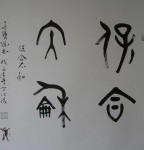| Article Index |
|---|
| Li Qi Stele(Bei) , 156AD, Han dynasty, Clerical Script |
| 第二页 |
| 第三页 |
| 第四页 |
| 第五页 |
| 第六页 |
| 第七页 |
| All Pages |
Li Qi Stele(Bei), Carved in 156, Clerical Script. Li Qi Bei's strokes are thin but not weak. The strokes are strong like steel.
The clerical script (simplified Chinese: 隶书; traditional Chinese: 隸書; pinyin: lìshū; Japanese: 隷書体, Reishotai;), formerly alsochancery script, is an archaic style of Chinese calligraphy which evolved in the Warring States period to the Qin dynasty, was dominant in the Han dynasty, and remained in use through the Wèi-Jìn (晉) periods. Due to its high legibility to modern readers, it is still used for artistic flavor in a variety of functional applications such as headlines, signboards and advertisements. This legibility stems from the highly rectilinear structure, a feature shared with modern regular script (kaishu). In structure and rectilinearity it is generally similar to the modern script; however, in contrast with the tall to square modern script, it tends to be square to wide, and often has a pronounced, wavelike flaring of isolated major strokes, especially a dominant rightward or downward diagonal stroke. Some structures are also archaic.
The Clerical Script (often simply termed lìshū; and sometimes called Official, Draft or Scribal Script) developed from the Seal Script. In general, characters are often "flat" in appearance, being wider than they are tall. The strokes may appear curvy, and often start thin and end thick. Most noticeable is the dramatically flared tail of one dominant horizontal or downward-diagonal stroke, especially that to the lower right. This characteristic stroke has famously been called 'silkworm head and wild goose tail' (蠶頭雁尾 cántóu yànwěi)in Chinese due to its distinctive shape.
The archaic Clerical Script of the Chinese Warring States period to Qin Dynasty and early Han Dynasty can often be difficult to read for a modern East Asian person, but the mature Clerical Script of the middle to late Han dynasty is generally legible. Modern works in the Clerical Script tend to use the mature, late Hàn style, and may also use modernized character structures, resulting in a form as transparent and legible as Regular (or standard) Script. The Clerical Script remains common as a typeface used for decorative purposes (for example, in displays), but it is not commonly written.
礼器碑 释文对照赏析:
释文:惟永寿二年青龙在涒叹霜月之灵皇
释文:极之日鲁相河南京韩君追惟太古华
| < Prev | Next > |
|---|
- 2008-12-23 - Harmony & Harmonious in Chinese Calligraphy, Big Seal Script Banner
- 2008-12-20 - 北宋 米芾《蜀素帖》(1088年), 行书
- 2008-12-18 - 唐朝颜真卿《颜氏家庙碑》(780年),楷书
- 2008-12-18 - 唐朝怀素《自叙帖》(777年),草书
- 2008-12-16 - 丁仕美行书书法对联《溪水、远山》
- 2008-12-13 - 秦朝《泰山刻石》(公元前219),小篆
- 2008-12-13 - The Orchid Pavilion (Lantingji Xu), Wang Xizhi, 353 AD, Semi-cursive script(Running Script)
- 2008-12-10 - 殷墟甲骨文《祭祀狩猎涂硃牛骨刻辞》
- 2008-12-05 - As Peace as Abyss in Chinese Calligraphy, Big Seal Script Banner
- 2008-12-03 - 丁仕美草书书法横幅,辛稼轩《青玉案·元夕》















